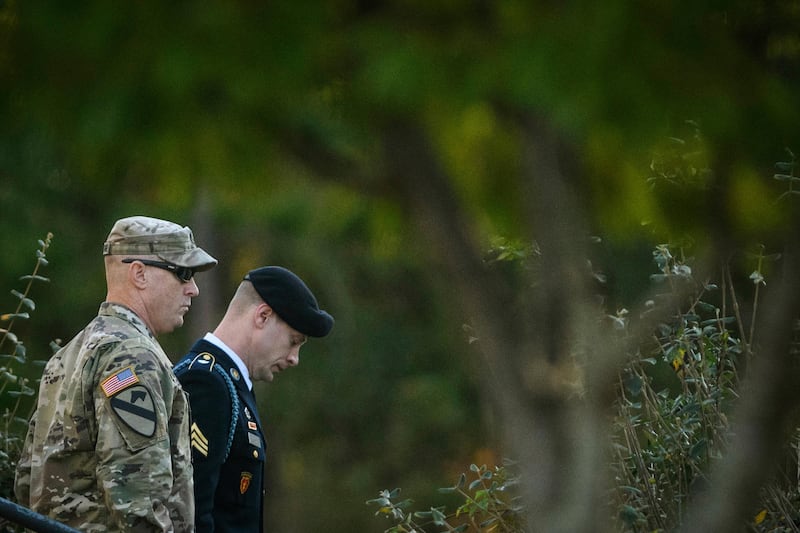Bowe Bergdahl had been in Afghanistan's Paktika province for six weeks when he formulated his plan.
Letters home offer a clue to his state of mind at the time.
“Leadership was lacking, if not non-existent,” he wrote to his parents during his time as a Taliban prisoner. “The conditions were bad and looked to be getting worse for the men that were actually the ones risking their lives from the attack.”
The idea was simple, he told the military officers who later debriefed him. No-one would have listened to the complaints of a private about morale and mismanagement, or his warnings that American soldiers might die because of bad decision-making.
Instead, he would walk to another base 20 miles away. The disappearance and reappearance of a soldier would set off such a firestorm, he reasoned, that any senior commander would have to hear him out.
“Suddenly he has a reason to believe that he should be listening to what this guy is saying,” he said in the transcript of his interview with investigating officers.
He set off on June 30, 2009, under cover of darkness. He wore Afghan clothes bought at a market pulled over his uniform. And he carried a few hundred dollars in case a bribe might smooth his way out of trouble.
_______________
Read more
[ Bowe Bergdahl trial: US troops were injured trying to rescue soldier ]
[ US soldier captured by Taliban pleads guilty to desertion ]
_______________
His plan fell apart after only a few hours walking through the hilly terrain. Soon after the sun came up he was spotted by members of the Taliban on motorcycles, the start of five years in captivity.
He was eventually freed in 2014 but his case remains a politically divisive issue. Members of his unit - the 501st Parachute Infantry Regiment – say the manhunt for the missing soldier cost lives (a fact disputed by senior officers, although at least three service personnel suffered life-changing injuries) and during last year’s election campaign Donald Trump accused him of treachery and suggested he should be shot.
In an interview with the Sunday Times, Mr Bergdahl, now 31, described his years in captivity, how he was beaten and tortured, and never knew if each day might be his last.
“The endless weeks, months, years on my own,” he said. “One, two, three years in a cage. In the end my mind became a broken record. Small things like staring at walls and staring at bugs on the ground — your mind becomes your own worst enemy and starts to go numb.”
His captors were part of the Haqqani network, a tribal militia that has one of the most brutal reputations among forces affiliated with the Taliban.
He was held in solitary confinement in Pakistan’s lawless tribal areas. After repeated escape attempts, he was locked inside a cage, no more than two metres square.
“The cage was suspended off the ground and the bars cut into my feet,” he said. “That’s why I ended up having permanent nerve damage. After the first winter in the cage, I lost the feeling in my feet.”
The Taliban kept up a steady stream of propaganda. Reports circulated that their prisoner had converted to Islam, taken up their cause and was even training fighters in bombmaking and ambush tactics.
At the same time, soldiers from his unit painted a picture of a homeschooled oddball. They described a man who would rather learn the local languages of Dari and Pashto than spend time drinking beer and eating burgers with other members of his platoon.
His parents in Idaho said that made him a gentle dreamer, as they kept up their efforts to bring him home.
His father Bob developed contacts with journalists in the region to gather information and also reached out to the Taliban in the hopes of persuading them to release his son.
The end came in May 2014. A video released by the Taliban shows Mr Bergdahl, dressed in baggy shalwaar kameez and clutching a plastic carrier bag, being handed over to American special forces in Afghanistan.
At a ceremony in the White House rose garden with Mr Bergdahl’s parents, President Barack Obama said: “He wasn't forgotten by his community in Idaho, or the military, which rallied to support the Bergdahls through thick and thin.
“And he wasn't forgotten by his country, because the United States of America does not ever leave our men and women in uniform behind.”
However, the release was every bit as controversial as the circumstances behind Mr Bergdhal’s abduction.
In exchange for his freedom, President Barack Obama agreed to release five senior Taliban prisoners being held at Guantanamo Bay.
The negotiations were held in Qatar, where the Taliban had a political presence and where the five prisoners were sent after their release.
The deal angered Mr Obama’s Republican critics, who said the five were a clear threat to the US and that negotiating with militant groups endangered Americans all around the world.
Mike Rogers, the then chairman of the House intelligence committee, said: "This fundamental shift in US policy signals to terrorists around the world a greater incentive to take US hostages."
The swirl of controversy about his disappearance and release mean Mr Bergdahl came home not as a hero but as a figure of suspicion.
Two months later he returned to work at Fort Sam Houston in San Antonio, Texas, where he was relegated to administrative duties. He was also given a bodyguard amid fears for his safety among troops who once considered comrades.
“The only time I’ve been able to breathe was when I was released and picked up by US special forces in the helicopter,” he said. “I had a brief moment of liberty. It’s been hard since then.”





